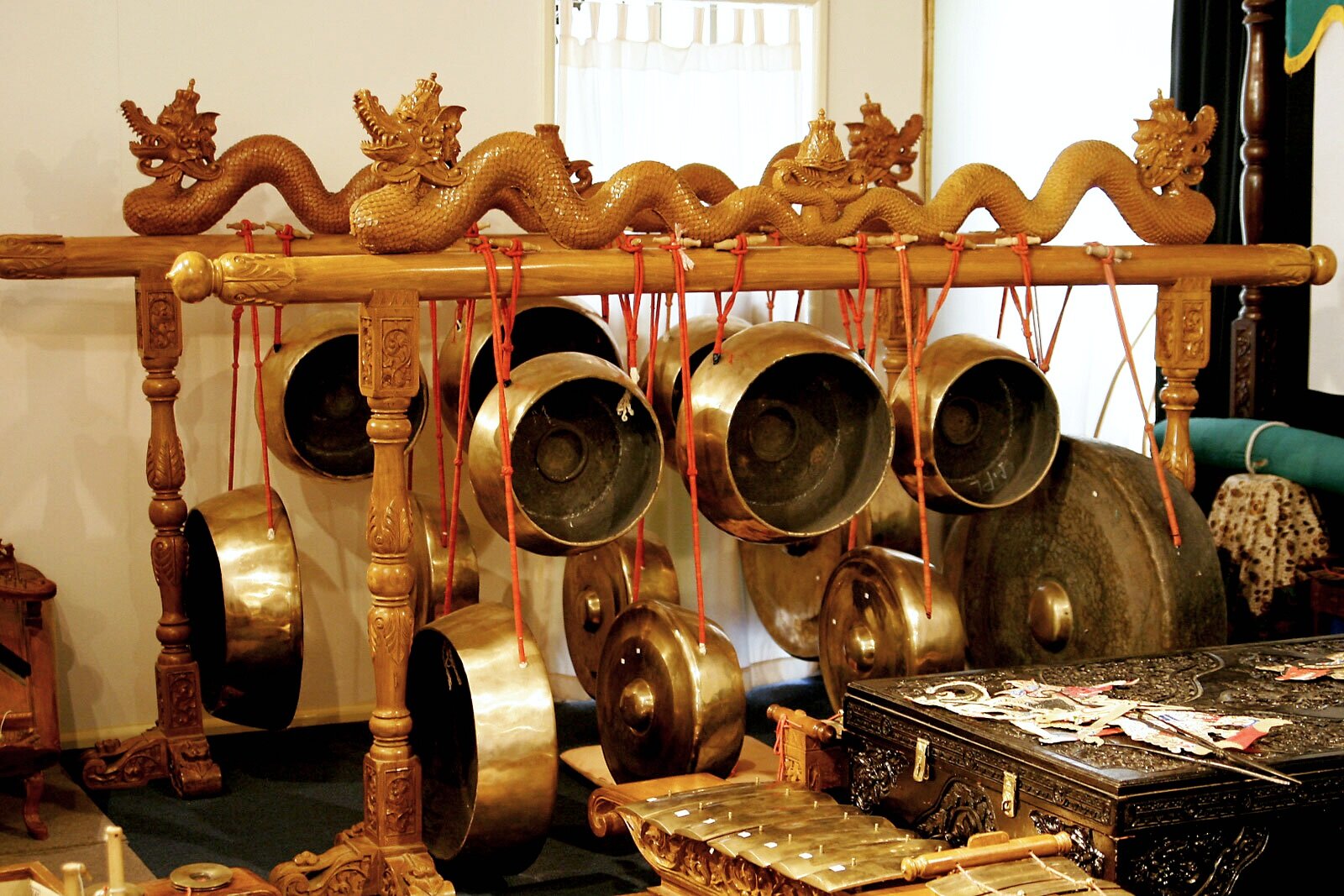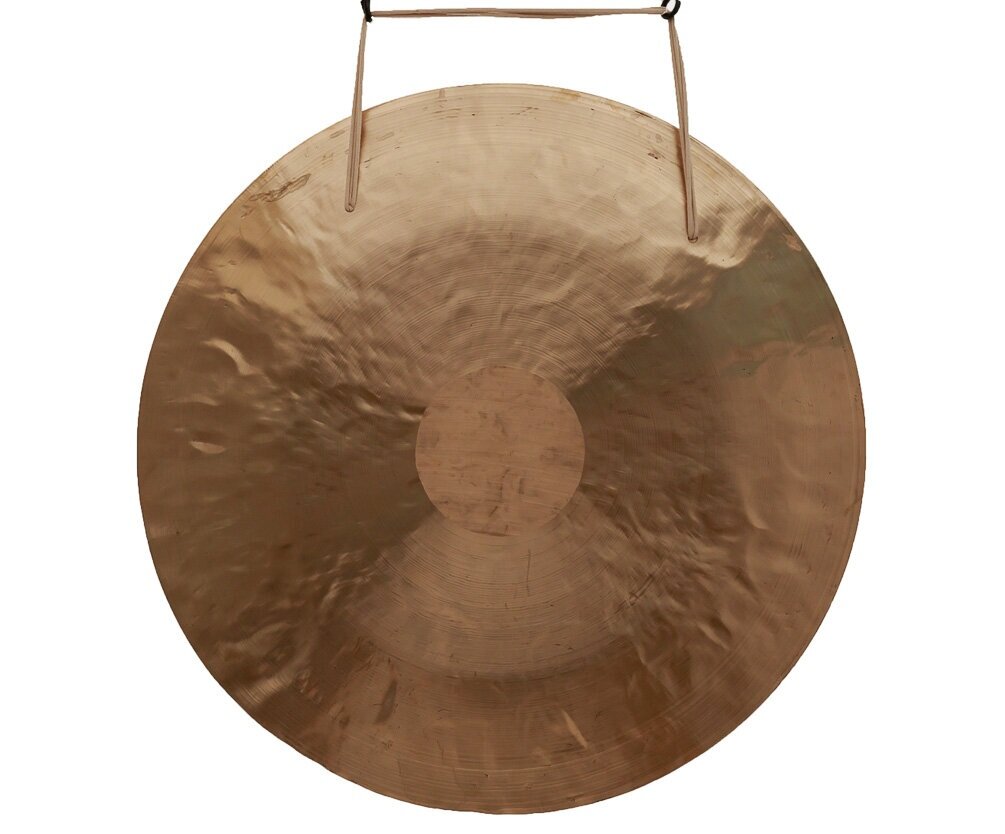
china
CHAU GONGS
Probably the oldest lineage of gongs available today and probably the most numerous. he Chau (also spelt Chao) gong is very popular with the majority of the world’s symphony orchestras, especially in the United States, as well as some of the big name orchestras in Europe e.g. the Berlin Philharmonic. The Chau gong is instantly recognisable with its black or dark brown centre and colouring around the edge of the face of the gong, with a shiny gold coloured mid band separating the two. This patterning gives it another name – the Bulls Eye Gong. It is also referred to as a ‘Chinese’ gong by both Zildjian and Sabian and as a ‘Tam-tam Gong’ by Stagg.
The gongs are made from cast bronze to a formula of approximately 76% copper to 23% tin plus traces of zinc and iron. Being of cast construction, the gongs have a certain brittleness and will crack or shatter if dropped onto a hard unyielding surface. They are also very heavy. A 40″/100 cm Chao gong weighs 45 pounds (20 kg)! The sizes range from about 10″/25 cm to 72″/180 cm in diameter.
The sound characteristics of a Chao gong are what most people describe as ‘Chinese’. When struck piano, has a very strong fundamental note though some harmonics and overtones shimmer quietly over the top. When played forte or fortissimo, the crash is much more immediate with lots of overtones, but decays away very quickly.
For sound healers, the Chao gong makes a very good ‘Earth’ gong – the word ‘earthy’ describing the sound very effectively. They make good alternatives to the German Sound Creation Earth gongs and Symphonic Gong as they produce a wide range of tones and harmonics, though some would say they are less pure than the nickel silver Symphonic Gong.
Wind (Feng) Gongs
Another popular Chinese gong is the ‘Wind’ gong. It is sometimes also known as a ‘Feng' gong. The Wind gong is essentially a flat gong, though it can be slightly convex like a flat shield, or it can be flat across most of the face but with a very shallow slope at the edges. It has no rim. The gong is normally cast into a pancake shaped mass and then beaten very thin though there are rolled sheet versions. They are mostly made from B20 bronze though M63 brass is also used. They are fully lathed front and rear and are extensively hammered.
There is a moderate fundamental note but the main characteristics of this instrument are the washing overtones and harmonics, crashing highs and brilliant shimmer that give this gong its name – a rushing wind through the bamboo groves. The sizes available are 6″/15cm to 60”/150cm.
They are rarely seen in orchestras as the fundamental note does not penetrate enough and the crash can be a bit too trashy for symphonic works. Where these gongs have found a major following is in sound therapy, Feng Shui, space clearing, yoga and other ‘New Age’ practices. The portability of even the larger sizes (24″ to 32″) makes them easy to walk with and carry round various rooms of the house or around a person’s body, sounding the gong as you go. The cost is also a big factor in their favour when compared to Chau or Paiste gongs.
Hand Gongs
Hand Held gongs are small gongs normally held in one hand for playing. They are often associated with Chinese theatre and lion, dog and dragon dances. These gongs often look and sound very similar, with the diameter of the instrument resulting in a different name as well as the gong’s use in a certain piece of theatre or dance.
The sounds and tones for these gongs can be bright, clear and bell-like or crashy and warm like a tam-tam, or even a combination of the two.
There are two basic shapes. One has a flat central section with the rest of the face gently sloping down to a shallow rim. The flat central section varies in diameter and often has an effect on the gong’s sound character. The other has a flat face which turns over into a deep rim. All are made from bronze though there are some brass versions.
Examples of hand gongs include Tiger, Pasi, White, Smooth, Xiang Jin, Jia, Dan da, Night, Wu, Se etc. The most famous of the hand gongs are the ‘Opera’ gongs with their distinctive up or down ‘glissandi’ (sliding sound).
Bao gongs are ‘tuned’ gongs and have a raised central boss within a gently sloping face and a reasonably deep rim. They can be obtained fully lathed and polished, partially lathed (e.g. just the central boss), or unfinished with just the black copper oxide coating. They are made from cast bronze and are lightly hammered. They are offered in sizes from 11″/27cm to 24″/60cm in 5cm steps. There are also several designs. Some have a shallow valley towards the edge of the face before turning over into a deep 2″ to 3″ rim. The gongs are made from slightly thicker gauge metal that gives an overall bell- like sound with subtle overtones and a short decay, though not particularly musical. The gongs can be tuned to Western scales and ‘Dream Gongs and Cymbals’ offer a range of tuned gongs based on the Bao to order and are musically superior to standard Bao gongs from other manufacturers.
south east asia
Java and Bali - Gamelan Gong
A gamelan is a musical ensemble from Indonesia, primarily associated with the islands of Bali and Java though variations can be found throughout the Malay Archipelago. The word ‘gamelan’ is derived from the word ‘gamel’ which most commonly translates as ‘to hit with a hammer’. The gongs of the gamelan are very distinctive, with a pronounced boss which can be either round or conical, a wide face and a deep rim sloping back towards the centre line of the gong. They are usually made from bronze though iron is not uncommon, and are made in a smithy known as a besalen.
The gongs of a Gamelan tend to fall into two categories;- those that are suspended vertically and those that are supported horizontally on a rack or on the knees or a cushion.
Gamelan - Vertically Suspended Gongs
The vertically suspended gongs are the largest in the gamelan. They are used to begin, end and punctuate different segments of the metric cycle. There are differences between Javanese and Balinese hanging gongs but all are sub-divided into three types – Bass Voice ( Jave - Gong Ageng, Gong Suwouk, Bali - Gong Wadeon, Gong Lanang), Middle Voice (Java – Kempul, Bali – Kempur, Bheri) and Treble Voice (Java – Kemong, Bali – Kemong, Klintong)
Gamelan - Horizontal Gongs
The horizontal gongs are played either in racks, singularly supported on a box resonator, or in the lap. The Javanese version is the Bonang, a double horizontal row of 10 to 14 gongs with round bosses. Other types are the Bonang Panerus, ,Bonang Panembung, and the Kenong,
The Balinese versions are the Trompong, consisting of 12 gongs with conical bosses, played by one person and the Reong, a horizontal row of small gongs with conical bosses played by one or more players. The gongs in both countries are played with cord wound wooden sticks.
Vietnamese Gongs
As in other parts of South-East Asia, particularly Burma, Thailand and Cambodia, the gong plays an important part in Vietnamese ceremonies, rites and religions. They are believed to be inhabited by spirits and represent a form of communication between humans and the spirit world. A person who possesses many gongs is highly respected, not because of wealth but because they are protected by many spirits. All Vietnamese families own or have access to gongs and they are often used during significant feasts, festivals, the birth of a child, the death of a family member, weddings, and even repairs to the house! Often, several people in the village will gather together with a variety of gongs, as an ensemble, with gongs ranging from 10″/25cm to 31″/80cm in diameter.
The Vietnamese gong shares a general shape with other gongs in this region. The boss is set in a flat face, which is heavily hammer-marked. Between the flat face and the rim, there is a shallow ‘channel’. The rim turns over and is either perpendicular to the face or gently slopes back in on itself. The rim is not very deep, usually between 1cm to 5cm depending on the size of the gong. The surface finish is a brown oxide layer which readily helps distinguish them from the neighbouring Burmese/Thai gongs which are dark green or black in colour. Their tone is bright and bell-like for the smaller gongs, moving to a richer ‘duum’ tone for the larger gongs.
Thai/Burmese Gongs
Gongs from Burma (or Myanmar as it is now known) have a long history and are often quoted as being the beginnings of gong making in South-East Asia along with China, Java and Amman. The Burmese gong has influenced other gong types in this region and is very similar to those found in Thailand, so they are often grouped together. Although there are several types of Burmese gong, the most common are the temple gongs and the triangular-shaped Kyeezee or ‘spinning’ gong.
The shape of the Burmese gong is one of the most recognisable. They are normally made from bronze and have a prominent round boss sitting on a slightly convex curving face with the edge of the boss being slightly recessed. There is a prominent lip moving over to a gently inwardly sloping rim which is deep – usually 1.5″/3cm to 5″/12cm depending on the size of the gong. The oxidised layer is left on the metal and can either be slate grey, black or bottle green in colour. The oxidised layer is often scraped to reveal various patterns, with lotus flower petals or star flower mandala patterns being the most common.
One thing to bear in mind when playing these gongs is that they need to be played with padded beaters and played quietly. They are cast gongs and can crack if played with a hard beater or struck with any force. The sound of the gong is a lovely low ‘dong’ with little overtones and no splash. The decay is fairly short lived and lasts the same length of time whether struck forte or piano.
The ‘Kyeezee’ is a triangular-shaped piece of bronze or brass, often decorated and carved and quite thick in cross-section. It is suspended on a cord at its mid point. When it is struck, it has a piercing bell-like tone and spinning the Kyeezee gives a warbling effect. They are often used in meditation. Both Zildjian and UFIP make their own versions of the Kyeezee called ‘Burmese Bells’.


